#Phangs Universe
Note
Is Crewel intentions the second book to Hunger Pangs? Is it just a short clip of what the second book hold?
I just finished reading Hunger Pangs and I want to read more, but I don't know what to buy. Crewel intentions seems to be a collection of short stories or a snipbit of what is to come.
Crewel Intentions is a "missing moment" scene from the not-yet-published second book. It's about 10k words and gives you a glimpse into how the trio functions together in their new relationship(s). It is somewhat spoiler-heavy for some major events that take place in book two.
If you want more content that doesn't include spoilers for book two, then the Hunger Pangs short, Lorehaven Bound, and is available for 99 cents from several major ebook retailers. (library links are still populating)
It's a missing moment from book one that is primarily from Ursula's perspective and gives you a bit more world-building and lore that'll get further expanded in the next book.
There's also a little snippet of Ivar and Alfbern interacting for the people who wanted more of those two winding each other up.
Hope that helps!
148 notes
·
View notes
Text
Why did you write two versions of Hunger Pangs?
WHAT’S THE DIFFERENCE AND IS ONE MORE “VALID” THAN THE OTHER?
I get a lot of questions when people find out I wrote two versions of Hunger Pangs (Phangs). To answer that second question first, the only difference is that one contains explicit sexual content, and the other merely alludes to it.
The Flirting with Fangs edition (red cover) contains multiple scenes that depict sexual acts, either solo or partnered. (link)
The Fluff and Fangs edition (blue cover) is less explicit. I say less because while the scene(s) fade to black, some elements of physical affection are still shown, along with a fairly involved conversation about consent and kink. This is in the latter half of Chapter 28, and as noted on my website, you can skip this part if it makes you uncomfortable and not miss anything important to either the plot or character development. (link)
Both versions contain heat ratings and content warnings on my website. I can’t put it in/on the books themselves because Amazon is going after authors for mentioning content warnings (link), so when in doubt, check www.joydemorra.com or send me a message!
And no, one version is not more “valid” than the other. Both are canon. If it helps, think of them as parallel universes running side by side down the narrative timeline. The plot and character development remain the same; the scenes have just been altered to accommodate reader preference.
THEN WHY DO THIS AT ALL?
As stated above, I wrote two different versions primarily to accommodate reader preference. When I first started writing Hunger Pangs: TLB, I was widely known on Tumblr for being “that erotica editor.” (link) I used to be a ghostwriter for my publishing house, too, so chances are some of you have already read my work under another author’s name*. A large chunk of my professional life has been spent writing sexually explicit content. It’s what I was then known and popular for, so it never occurred to me that anyone who was sex averse or didn’t enjoy reading about sex would be interested in my work.
And then those exact people started messaging me to let me know they were super excited about my work, couldn’t wait to buy a copy and would just skip past the sex parts that made them uncomfortable.
And that didn’t sit right with me.
Phangs is a bit of a weird project. It was started via a Tumblr shitpost (link) and grew from there. It was funded entirely by the support of my Patreon, which people kept supporting even after it took me years longer to finish it than initially planned because my health took a proverbial nose dive into the tenth circle of hell. It is not an exaggeration to say my Patreon and Tumblr kept me alive during that time. You kept our lights on and put what little food I could eat into my fridge. You supported me both physically and emotionally during one of the worst times of my life. And during that time, I wrote the entire Phangs series, assuming it would be edited and published posthumously**. It was both my swan song and a parting gift. A means of saying thank you for all your support over the years and the fervent hope you’d feel my love on every page. Because never doubt this, I wrote Phangs for you. Phangs is a love letter to fandom from start to finish. It’s written specifically to appeal to fandom and all the things we love about it.
So when people told me they were going to buy it but skip parts of it, I felt the need to make sure they were getting equal amounts of content for their money. So the “fluff” version of the narrative was born, replacing the sex-based scenes with more emotional and “fluffy” but still intimate interactions that keep the character arcs and plot intact.
For the first book, I tried to keep the scenes as similar in theme as possible. That’s why Chapter 28 still features a frank discussion around kink and consent, as a large part of Vlad’s character arc is learning that his wants and desires matter, but more importantly, so do his boundaries. But I also purposefully wrote it so that you can skip away after that conversation and not miss anything in the lead-up to the fade to black/implied sex scene. As the series progresses, the scenes may differ more as I play around having fun with it. But the fact remains that the characterization and plot will always stay true.
It’s merely about what kind of reading experience you want.
Do I expect other authors to do this? Absolutely not. This is a labor of love. The “fluff” version being popular is merely a bonus that enables me to keep writing. So thank you. I’m off to keep working on the next story.
*Before anyone asks, no, I can’t tell you who. I signed NDAs that are still in effect.
**Jokes on me, I guess, because I lived, and now I have to edit and rewrite all 500-f*cking-k of it.
76 notes
·
View notes
Text
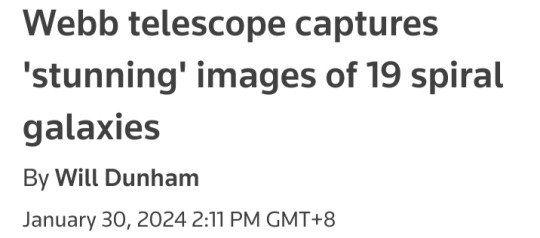
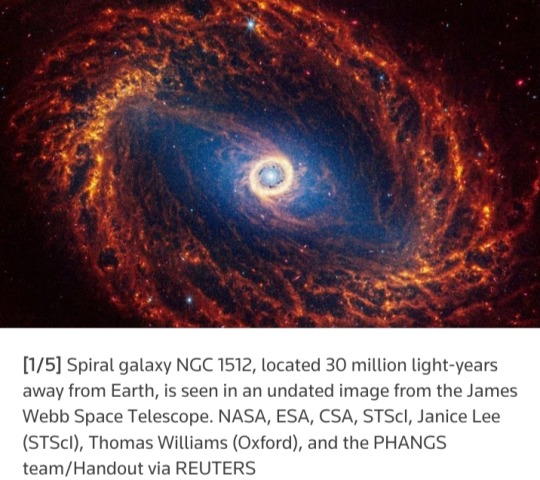
WASHINGTON, Jan 29 (Reuters) — A batch of newly released images captured by the James Webb Space Telescope show in remarkable detail 19 spiral galaxies residing relatively near our Milky Way, offering new clues on star formation as well as galactic structure and evolution.
The images were made public on Monday by a team of scientists involved in a project called Physics at High Angular resolution in Nearby GalaxieS (PHANGS) that operates across several major astronomical observatories.
The closest of the 19 galaxies is called NGC5068, about 15 million light years from Earth, and the most distant of them is NGC1365, about 60 million light years from Earth.
A light year is the distance light travels in a year, 5.9 trillion miles (9.5 trillion km).
The James Webb Space Telescope (JWST) was launched in 2021 and began collecting data in 2022, reshaping the understanding of the early universe while taking wondrous pictures of the cosmos.
The orbiting observatory looks at the universe mainly in the infrared.
The Hubble Space Telescope, launched in 1990 and still operational, has examined it primarily at optical and ultraviolet wavelengths.
Spiral galaxies, resembling enormous pinwheels, are a common galaxy type. Our Milky Way is one.
The new observations came from Webb's Near-Infrared Camera (NIRCam) and Mid-Infrared Instrument (MIRI).
They show roughly 100,000 star clusters and millions or perhaps billions of individual stars.
"These data are important as they give us a new view on the earliest phase of star formation," said University of Oxford astronomer Thomas Williams, who led the team's data processing on the images.
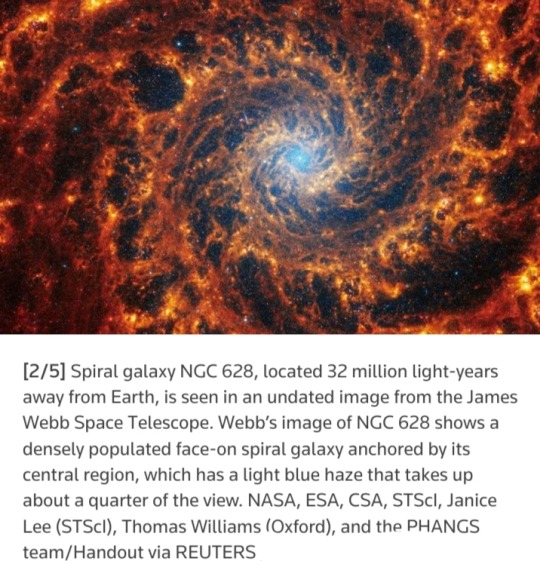
"Stars are born deep within dusty clouds that completely block out the light at visible wavelengths - what the Hubble Space Telescope is sensitive to - but these clouds light up at the JWST wavelengths.
We don't know a lot about this phase, not even really how long it lasts, and so these data will be vital for understanding how stars in galaxies start their lives," Williams added.
About half of spiral galaxies have a straight structure, called a bar, coming out from the galactic center to which the spiral arms are attached.
"The commonly held thought is that galaxies form from the inside-out, and so get bigger and bigger over their lifetimes.
The spiral arms act to sweep up the gas that will form into stars, and the bars act to funnel that same gas in towards the central black hole of the galaxy," Williams said.

The images let scientists for the first time resolve the structure of the clouds of dust and gas from which stars and planets form at a high level of detail in galaxies beyond the Large Magellanic Cloud and Small Magellanic Cloud, two galaxies considered galactic satellites of the sprawling Milky Way.
"The images are not only aesthetically stunning, they also tell a story about the cycle of star formation and feedback, which is the energy and momentum released by young stars into the space between stars," said astronomer Janice Lee of the Space Telescope Science Institute in Baltimore, principal investigator for the new data.
"It actually looks like there was explosive activity and clearing of the dust and gas on both cluster and kiloparsec (roughly 3,000 light years) scales.
The dynamic process of the overall star formation cycle becomes obvious and qualitatively accessible, even for the public, which makes the images compelling on many different levels," Lee added.
Webb's observations build on Hubble's.

"Using Hubble, we would see the starlight from galaxies, but some of the light was blocked by the dust of galaxies," University of Alberta astronomer Erik Rosolowsky said.
"This limitation made it hard to understand parts of how a galaxy operates as a system. With Webb's view in the infrared, we can see through this dust to see stars behind and within the enshrouding dust."
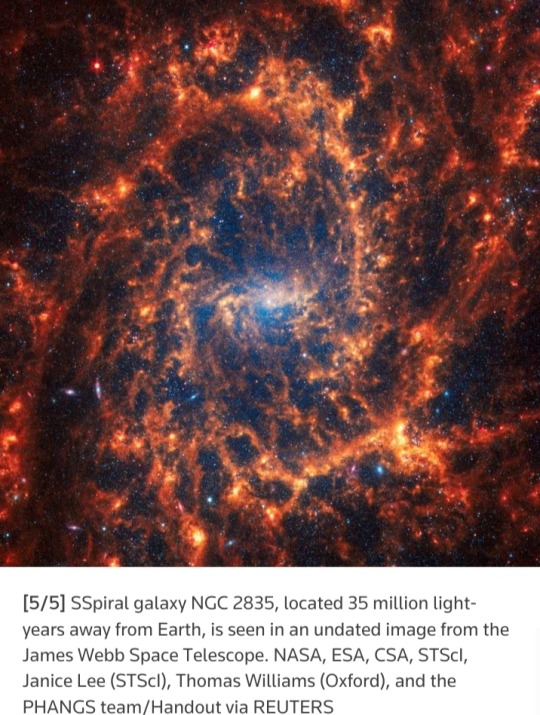
#James Webb Space Telescope#spiral galaxies#Milky Way#Physics at High Angular resolution in Nearby GalaxieS (PHANGS)#NGC5068#NGC1365#light year#Hubble Space Telescope#Near-Infrared Camera (NIRCam)#Mid-Infrared Instrument (MIRI)#astronomy#space#universe#cosmos#Large Magellanic Cloud#Small Magellanic Cloud#Space Telescope Science Institute
37 notes
·
View notes
Photo

Posted @withregram • @jameswebb_nasa Webb: transforming the ordinary into the extraordinary. ✨🪐 This time, Jupiter reveals itself in a new color scheme through JWST’s Near-Infrared Camera. The first observation features visible auroras that extend to high altitudes above Jupiter's northern and southern poles. Bright waves, swirls, and vortices in Jupiter's atmosphere are easily visible on the second and third pictures. • Processing: Ricardo Hueso (UPV/EHU) & Judy Schmidt #Jupiter #NIRCam #PHANGS #STScI #Webb #WebbSeesFarther #space #universe #science #physics #nature #infrared #solarsystem #telescope #jameswebb #jameswebbspacetelescope #staycurious https://www.instagram.com/p/ChpBMLZuoMO/?igshid=NGJjMDIxMWI=
#jupiter#nircam#phangs#stsci#webb#webbseesfarther#space#universe#science#physics#nature#infrared#solarsystem#telescope#jameswebb#jameswebbspacetelescope#staycurious
0 notes
Photo


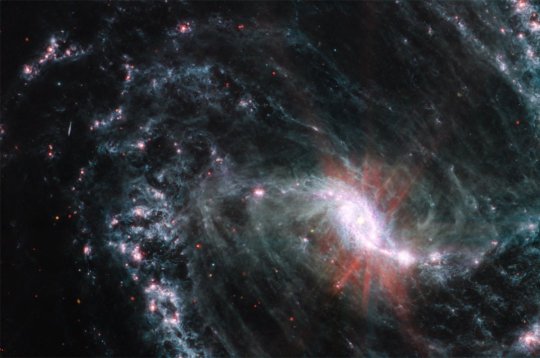
NASA’s Webb Reveals Intricate Networks of Gas, Dust in Nearby Galaxies Peering through obscuring clouds of dust, the MIRI instrument has revealed networks of giant cavities and blown-out bubbles in the gaseous arms of distant galaxies. Researchers using NASA’s James Webb Space Telescope are getting their first look at star formation, gas, and dust in nearby galaxies with unprecedented resolution at infrared wavelengths. The data has enabled an initial collection of 21 research papers which provide new insight into how some of the smallest-scale processes in our universe – the beginnings of star formation – impact the evolution of the largest objects in our cosmos: galaxies. The largest survey of nearby galaxies in Webb’s first year of science operations is being carried out by the Physics at High Angular resolution in Nearby Galaxies (PHANGS) collaboration, involving more than 100 researchers from around the globe. The Webb observations are led by Janice Lee, Gemini Observatory chief scientist at the National Science Foundation’s NOIRLab and affiliate astronomer at the University of Arizona in Tucson. The team is studying a diverse sample of 19 spiral galaxies, and in Webb’s first few months of science operations, observations of five of those targets – M74, NGC 7496, IC 5332, NGC 1365, and NGC 1433 – have taken place. The results are already astounding astronomers. “The clarity with which we are seeing the fine structure certainly caught us by surprise,” said team member David Thilker of Johns Hopkins University in Baltimore, Maryland. “We are directly seeing how the energy from the formation of young stars affects the gas around them, and it’s just remarkable,” said team member Erik Rosolowsky of the University of Alberta, Canada. The images from Webb’s Mid-Infrared Instrument (MIRI) reveal the presence of a network of highly structured features within these galaxies – glowing cavities of dust and huge cavernous bubbles of gas that line the spiral arms. In some regions of the nearby galaxies observed, this web of features appears built from both individual and overlapping shells and bubbles where young stars are releasing energy. “Areas which are completely dark in Hubble imaging light up in exquisite detail in these new infrared images, allowing us to study how the dust in the interstellar medium has absorbed the light from forming stars and emitted it back out in the infrared, illuminating an intricate network of gas and dust,” said team member Karin Sandstrom of the University of California, San Diego. The high-resolution imaging needed to study these structures has long evaded astronomers – until Webb came into the picture. “The PHANGS team has spent years observing these galaxies at optical, radio, and ultraviolent wavelengths using NASA’s Hubble Space Telescope, the Atacama Large Millimeter/Submillimeter Array, and the Very Large Telescope’s Multi Unit Spectroscopic Explorer,” added team member Adam Leroy of the Ohio State University. “But the earliest stages of a star’s life cycle have remained out of view because the process is enshrouded within gas and dust clouds.” Webb’s powerful infrared capabilities can pierce through the dust to connect the missing puzzle pieces. For example, specific wavelengths observable by MIRI (7.7 and 11.3 microns) and Webb’s Near-Infrared Camera (3.3 microns) are sensitive to emission from polycyclic aromatic hydrocarbons, which play a critical role in the formation of stars and planets. These molecules were detected by Webb in the first observations by the PHANGS program. Studying these interactions at the finest scale can help provide insights into the larger picture of how galaxies have evolved over time. “Because these observations are taken as part of what's called a treasury program, they are available to the public as they are observed and received on Earth,” said Eva Schinnerer of the Max Planck Institute for Astronomy in Heidelberg, Germany, and leader of the PHANGS collaboration. The PHANGS team will work to create and release data sets that align Webb’s data to each of the complementary data sets obtained previously from the other observatories, to help accelerate discovery by the broader astronomical community. “Thanks to the telescope’s resolution, for the first time we can conduct a complete census of star formation, and take inventories of the interstellar medium bubble structures in nearby galaxies beyond the Local Group,” Lee said. “That census will help us understand how star formation and its feedback imprint themselves on the interstellar medium, then give rise to the next generation of stars, or how it actually impedes the next generation of stars from being formed.” The research by the PHANGS team is being conducted as part of General Observer program 2107. The team’s initial findings, composed of 21 individual studies, were recently published in a special focus issue of The Astrophysical Journal Letters. More About the Mission The James Webb Space Telescope is the world’s premier space science observatory. Webb will solve mysteries in our solar system, look beyond to distant worlds around other stars, and probe the mysterious structures and origins of our universe and our place in it. Webb is an international program led by NASA with its partners, ESA (European Space Agency), and CSA (Canadian Space Agency). MIRI was developed through a 50-50 partnership between NASA and ESA. NASA’s Jet Propulsion Laboratory led the U.S. efforts for MIRI, and a multinational consortium of European astronomical institutes contributes for ESA. George Rieke with the University of Arizona is the MIRI science team lead. Gillian Wright is the MIRI European principal investigator. Laszlo Tamas with UK ATC manages the European Consortium. The MIRI cryocooler development was led and managed by JPL, in collaboration with Northrop Grumman in Redondo Beach, California, and NASA’s Goddard Space Flight Center in Greenbelt, Maryland. TOP IMAGE....The Mid-Infrared Instrument (MIRI) on NASA’s James Webb Space Telescope took this image of NGC 1433, a barred spiral galaxy with a particularly bright core surrounded by double star-forming rings. The observations reveal cavernous bubbles of gas where forming stars have released energy. Credit: NASA, ESA, CSA, and J. Lee (NOIRLab). Image processing: A. Pagan (STScI) CENTRE IMAGHE....The spiral arms of galaxy NGC 7496 are filled with cavernous bubbles and shells overlapping one another in this image from MIRI. These filaments and hollow cavities are evidence of young stars releasing energy and, in some cases, blowing out the gas and dust of the interstellar medium surrounding them. Credit: NASA, ESA, CSA, and J. Lee (NOIRLab). Image processing: A. Pagan (STScI) LOWER IMAGE....In this MIRI image of galaxy NGC 1365, clumps of dust and gas in the interstellar medium have absorbed the light from forming stars and emitted it back out as infrared light. This illuminates an intricate network of cavernous bubbles and filamentary shells. Credit: NASA, ESA, CSA, and J. Lee (NOIRLab). Image processing: A. Pagan (STScI)
91 notes
·
View notes
Video
<strong>Webb Inspects the Heart of the Phantom Galaxy <a href="https://www.flickr.com/photos/nasawebbtelescope/">by NASA's James Webb Space Telescope</a></strong> <br /><i>Via Flickr:</i> <br />This image from the James Webb Space Telescope shows the heart of M74, otherwise known as the Phantom Galaxy. Webb’s sharp vision has revealed delicate filaments of gas and dust in the grandiose spiral arms which wind outwards from the centre of this image. A lack of gas in the nuclear region also provides an unobscured view of the nuclear star cluster at the galaxy's centre.
M74 is a particular class of spiral galaxy known as a ‘grand design spiral’, meaning that its spiral arms are prominent and well-defined, unlike the patchy and ragged structure seen in some spiral galaxies. The Phantom Galaxy is around 32 million light-years away from Earth in the constellation Pisces, and lies almost face-on to Earth. This, coupled with its well-defined spiral arms, makes it a favorite target for astronomers studying the origin and structure of galactic spirals.
Webb gazed into M74 with its Mid-InfraRed Instrument (MIRI) in order to learn more about the earliest phases of star formation in the local Universe. These observations are part of a larger effort to chart 19 nearby star-forming galaxies in the infrared by the international PHANGS collaboration. Those galaxies have already been observed using the Hubble Space Telescope and ground-based observatories. The addition of crystal-clear Webb observations at longer wavelengths will allow astronomers to pinpoint star-forming regions in the galaxies, accurately measure the masses and ages of star clusters, and gain insights into the nature of the small grains of dust drifting in interstellar space.
Hubble observations of M74 have revealed particularly bright areas of star formation known as HII regions. Hubble’s sharp vision at ultraviolet and visible wavelengths complements Webb’s unparalleled sensitivity at infrared wavelengths, as do observations from ground-based radio telescopes such as the Atacama Large Millimeter/submillimeter Array, ALMA. By combining data from telescopes operating across the electromagnetic spectrum, scientists can gain greater insight into astronomical objects than by using a single observatory — even one as powerful as Webb! MIRI was contributed by ESA and NASA, with the instrument designed and built by a consortium of nationally funded European Institutes (the MIRI European Consortium) in partnership with JPL and the University of Arizona.
This image was processed by ESA.
Read more: esawebb.org/images/potm2208a/
Image credit: ESA/Webb, NASA & CSA, J. Lee and the PHANGS-JWST Team. Acknowledgement: J. Schmidt
Image description:
Delicate gray, webby filaments form a spiral pattern winding outwards from the center of the galaxy. These spiral arms of the galaxy are traced by blue and bursts of pink; these are the regions in which stars are forming. The very heart of the galaxy is colored blue and has speckles, which are young stars, which are forming around the nucleus of the galaxy.
45 notes
·
View notes
Text
This image from the James Webb Telescope shows the heart of M74, otherwise known as the Phantom Galaxy. Webb’s sharp vision has revealed delicate filaments of gas and dust in the grandiose spiral arms which wind outwards from the centre of this image. A lack of gas in the nuclear region also provides an unobscured view of the nuclear star cluster at the galaxy's centre. M74 is a particular class of spiral galaxy known as a ‘grand design spiral’, meaning that its spiral arms are prominent and well-defined, unlike the patchy and ragged structure seen in some spiral galaxies.
The Phantom Galaxy is around 32 million light-years away from Earth in the constellation Pisces, and lies almost face-on to Earth. This, coupled with its well-defined spiral arms, makes it a favourite target for astronomers studying the origin and structure of galactic spirals.
Webb gazed into M74 to learn more about the earliest phases of star formation in the local Universe. These observations are part of a larger effort to chart 19 nearby star-forming galaxies in the infrared by the international PHANGS collaboration. Those galaxies have already been observed using the Hubble Telescope and ground-based observatories. The addition of crystal-clear Webb observations at longer wavelengths will allow astronomers to pinpoint star-forming regions in the galaxies, accurately measure the masses and ages of star clusters, and gain insights into the nature of the small grains of dust drifting in interstellar space.
Credit: ESA/Webb, NASA & CSA, J. Lee and the PHANGS-JWST Team.
Acknowledgement: J. Schmidt

#science#universo#outer space#astronomy#space science#space exploration#astronomy news#space#research#a cosmic time machine how the james webb space telescope lets us see the first galaxies in the universe jwst#james webb deepest sharpest view of universe#james webb update#james webb images#james webb space telescope#james webb space technology#james webb photos
4 notes
·
View notes
Text
<b>Trump</b> trials face series of delays as Supreme Court takes up immunity appeal - YouTube
New Post has been published on https://www.google.com/url?rct=j&sa=t&url=https://www.youtube.com/watch%3Fv%3DZVfd199oxXA&ct=ga&cd=CAIyGjUzM2UwMTY5ZmFhZTIwMGQ6Y29tOmVuOlVT&usg=AOvVaw0UPY4CEPhwZxU7RjtJ0Vmg
Trump trials face series of delays as Supreme Court takes up immunity appeal - YouTube
Assistant Professor of Law at Georgia State University Anthony Michael Kreis and MSNBC legal analyst Paul Butler join Katie Phang to discuss the …
0 notes
Text
Tsunami Museum Khao Lak

The Tsunami Museum Khao Lak, located in Thailand, was created to commemorate the devastating disaster. It highlights the loss of many lives during that time and the preparation for the future Tsubami. Stay tuned with the itinerary plan we will inform you about the museum.
History of Tsunami Museum Khao Lak
The history of the Tsunami Museum Khao Lak is a poignant story of resilience and education born from tragedy. Here’s a deeper dive:
Origin: In the aftermath of the devastating 2004 Indian Ocean tsunami, the Khao Lak community was left reeling. Recognizing the need for remembrance and education, students from Phang Nga University initiated the museum project in 2006.https://itineraryplans.com/place/tsunami-museum-khao-lak/…#TsunamiMuseumKhaoLak#Thailand#ThailandTravel#ItineraryPlans#ItineraryBlog
0 notes
Note
Misread your last post and I thought for a second that you said batmuppet is cannon to the Phangs universe. I’m choosing to keep believing this.
*snorts*
I mean, I've written Phangs as being a piece of media in the Batmuppet universe, so yeah, fair. Law of alternate realities. And all that.
407 notes
·
View notes
Text
NGC 4254's Swirling Spectacle Captured by James Webb Telescope

Exploring the Dazzling Swirls of Spiral Galaxy NGC 4254
The universe is a vast expanse of mysteries and marvels, and nestled within this cosmic sea is NGC 4254, a spiral galaxy that captures the imagination with its stunning swirls and vibrant hues. Thanks to the unparalleled capabilities of NASA’s James Webb Space Telescope, astronomers and enthusiasts alike can now explore this celestial wonder in unprecedented detail.
A Glimpse into the Cosmos
On January 29, 2024, the James Webb Space Telescope offered the world a mesmerizing view of NGC 4254. Moreover, adorned in radiant orange and blue, this image is part of a broader effort by the Physics at High Angular Resolution in Nearby GalaxieS (PHANGS) program. This initiative aims to study 19 nearby spiral galaxies. Additionally, supported by over 150 astronomers globally, PHANGS leverages James Webb's state-of-the-art technology to peel back the layers of these spiraled giants.
Webb's Infrared Eyes
The James Webb Space Telescope's power lies in its observation capabilities. Unlike its predecessors, Webb delves into the infrared spectrum, revealing celestial objects and phenomena previously shrouded in mystery. Its Near-Infrared Camera (NIRCam) captures the sparkling blue tones of millions of stars, while the Mid-Infrared Instrument (MIRI) illuminates the glowing dust that exists around and between these stars, painting a picture of cosmic creation and destruction.
The Significance of NGC 4254
NGC 4254 stands as a testament to the dynamic processes that govern our universe. Its clearly defined arms, brimming with stars, wind towards a center that may host ancient star clusters and occasionally, active supermassive black holes. This galaxy, like others in the PHANGS survey, offers invaluable insights into the lifecycle of stars, the distribution of cosmic dust, and the conditions that lead to the formation of black holes.
The Revolution of James Webb
The James Webb Space Telescope has ushered in a new era of cosmic exploration. By observing the universe in infrared light, Webb extends our gaze farther and deeper than ever before, unveiling objects and phenomena that were once beyond our reach. This revolutionary observatory has not only enhanced our understanding of galaxies like NGC 4254 but has also shed light on the early universe, the mysterious dark matter, and the dark energy that permeates space.
Webb's Contributions to Solar System Science
Beyond its exploration of distant galaxies, the James Webb Space Telescope has significantly advanced our knowledge of the solar system. It has identified new asteroids and comets, offered detailed studies of planetary and moon atmospheres, and provided fresh insights into the formation and evolution of our cosmic neighborhood.
The James Webb Space Telescope's image of NGC 4254 is more than just a photograph; it's a gateway to understanding the complexities and beauty of the universe. As we continue to analyze and marvel at these images, we inch closer to unraveling the mysteries of our cosmos, reminding us of the endless wonders that await discovery.
Sources: THX News & NASA.
Read the full article
#celestialobjects#cosmicdust#cosmicexploration#infraredlight#JamesWebbSpaceTelescope#Mid-InfraredInstrument#Near-InfraredCamera#NGC4254#PHANGSprogram#spiralgalaxy
0 notes
Photo

#incredible Posted @withregram • @jameswebb_nasa Webb: transforming the ordinary into the extraordinary. ✨🪐 This time, Jupiter reveals itself in a new color scheme through JWST’s Near-Infrared Camera. The first observation features visible auroras that extend to high altitudes above Jupiter's northern and southern poles. Bright waves, swirls, and vortices in Jupiter's atmosphere are easily visible on the second and third pictures. • Processing: Ricardo Hueso (UPV/EHU) & Judy Schmidt #Jupiter #NIRCam #PHANGS #STScI #Webb #WebbSeesFarther #jwst #jameswebb #jameswebbspacetelescope #infrared #telescope #nature #space #universe #solarsystem https://www.instagram.com/p/ChpANCLOyft/?igshid=NGJjMDIxMWI=
#incredible#jupiter#nircam#phangs#stsci#webb#webbseesfarther#jwst#jameswebb#jameswebbspacetelescope#infrared#telescope#nature#space#universe#solarsystem
0 notes
Photo

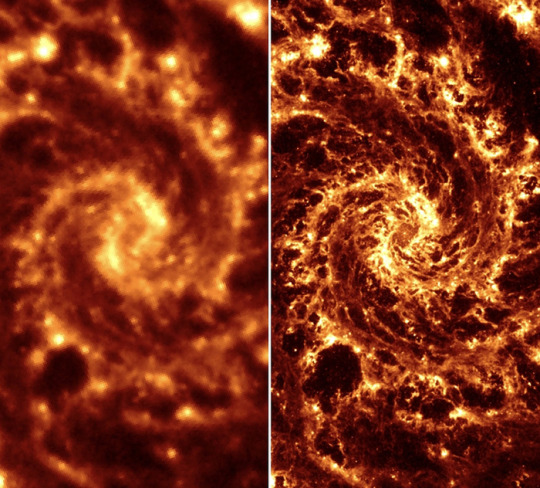
A star is born: Images of nearby galaxies provide clues about star formation It is a popular notion that aside from large celestial objects like planets, stars and asteroids, outer space is empty. In fact, galaxies are filled with something called the interstellar medium (ISM) — that is, the gas and dust that permeate the space in between those large objects. Importantly, under the right conditions, it is from the ISM that new stars are formed. Now researchers from the University of California San Diego, in collaboration with a worldwide project team, have released their findings in a special issue of The Astrophysical Journal Letters dedicated to their work using advanced telescope images through the JWST Cycle 1 Treasury Program. “With JWST, you can make incredible maps of nearby galaxies at very high resolution that provide amazingly detailed images of the interstellar medium,” stated Associate Professor of Physics Karin Sandstrom who is a co-principal investigator on the project. Although JWST can look at very distant galaxies, the ones Sandstrom’s group studied are relatively close at about 30 million light years away, including one known as the Phantom Galaxy. Also known as M74 or NGC 628, astronomers have known of the Phantom Galaxy’s existence since at least the 18th century. Sandstrom, along with postdoctoral scholar Jessica Sutter and former postdoctoral scholar Jeremy Chastenet (now at University of Ghent), focused on a specific component of the ISM called polycyclic aromatic hydrocarbons (PAHs). PAHs are small particles of dust — the size of a molecule — and it’s their small size that makes them so valuable to researchers. When PAHs absorb a photon from a star, they vibrate and produce emission features that can be detected in the mid-infrared electromagnetic spectrum — something that typically doesn’t happen with larger dust grains from the ISM. The vibrational features of PAHs allow researchers to observe many important characteristics including size, ionization and structure. This is something Sandstrom has been interested in since graduate school. “The Spitzer Space Telescope looked at the mid-infrared and that's what I used in my Ph.D. thesis. Since Spitzer was retired, we haven't had much access to the mid-infrared spectrum, but JWST is incredible,” she stated. “Spitzer had a mirror that was 0.8 meters; JWST’s mirror is 6.5 meters. It's a huge telescope and it has amazing instruments. I've been waiting a very long time for this.” Even though PAHs are not by mass a big fraction of the overall ISM, they're important because they’re easily ionized — a process that can produce photoelectrons which heat the rest of the gas in the ISM. A better understanding of PAHs will lead to a better understanding of the physics of the ISM and how it operates. Astrophysicists are hopeful JWST can provide a view into how PAHs are formed, how they change and how they’re destroyed. Because PAHs are evenly distributed throughout the ISM, they allow researchers to see not just the PAHs themselves, but everything around them as well. Previous maps, such as ones taken by Spitzer, contained much less detail — they essentially looked like galactic blobs. With the clarity JWST provides, astrophysicists can now see gas filaments and even “bubbles” blown by newly formed stars, whose intense radiation fields and resulting supernova evaporate the gas clouds around them. To get observation time on JWST, the Cycle 1 Treasury Program team had to design observations that included details such as exposure length and filters. Once their submission was accepted, Space Telescope Science Institute, which is responsible for the science and mission operations for JWST, captures and processes the data. This program includes data from 19 galaxies in total. The Cycle 1 Treasury Program is part of a bigger project called PHANGS (Physics at High Angular Resolution in Nearby GalaxieS). PHANGS studies star formation and the ISM using multi-wavelength images from the Atacama Large Millimeter Array (ALMA) and the Very Large Telescope, both in Chile. However, because the dense clouds in which star formation happens contain a lot of dust, it is difficult for optical light to penetrate to see what's happening inside. Using the mid-infrared spectrum allows researchers to use that same dust and its bright emission to get high-resolution, detailed images. “One of the things I'm most excited about is now that we have this high-resolution tracer of the ISM, we can map all kinds of things, including the structure of the diffuse gas, which has to become denser and molecular for star formation to occur,” said Sandstrom. “We can also map the gas surrounding newly formed stars where there is a lot of ‘feedback’ such as from supernova explosions. We really get to see the whole cycle of the ISM in a lot of detail. That is the core of how a galaxy is going to form stars.” TOP IMAGE....NGC 7496 lies over 24 million light-years away from Earth in the constellation Grus, and is one of 19 galaxies targeted for study by PHANGS. Its spiral arms are filled with cavernous bubbles and shells overlapping one another in this image from JWST's Mid-Infrared Instrument (MIRI). These filaments and hollow cavities are evidence of young stars releasing energy and, in some cases, blowing out the gas and dust of the interstellar medium surrounding them. At the center of NGC 7496 is an active galactic nucleus -- another way to refer to an active supermassive black hole. (cr: NASA, ESA, CSA, Joseph DePasquale/STScI) LOWER IMAGES....A side-by-side comparison of NGC 628 (Phantom Galaxy) images taken from the Spitzer Space Telescope (l) and JWST (r) show a remarkable increase in clarity and detail. CREDIT SST cr: NASA/JPL-CalTech; JWST cr: NASA, ESA, CSA, STScI
46 notes
·
View notes
Text
SomewhereDeepInTheNight #ToTheSky
"While conducting a census of nearly 100 galaxies in the nearby Universe, the PHANGS survey observed NGC0628, a galaxy with pure grand-design spiral morphology. NGC0628 is shown here as an ALMA (orange) composite with Hubble Space Telescope (red) data. "
0 notes
Text
Stunning spiral galaxies seen in new James Webb Space Telescope images - Technology Org
New Post has been published on https://thedigitalinsider.com/stunning-spiral-galaxies-seen-in-new-james-webb-space-telescope-images-technology-org/
Stunning spiral galaxies seen in new James Webb Space Telescope images - Technology Org
A set of highly detailed images of 19 nearby spiral galaxies from NASA’s James Webb Space Telescope (JWST) have been publicly released. The suite of extraordinary images will provide several new puzzle pieces for astronomers and astrophysicists around the world. JWST’s NIRCam (Near-Infrared Camera) captured millions of stars in the images, which sparkle in blue tones. Some stars are spread throughout the spiral arms, but others are clumped tightly together in star clusters. The telescope’s MIRI (Mid-Infrared Instrument) data highlights glowing dust, showing where it exists around and between stars. It also spotlights stars that haven’t yet fully formed – they are still encased in the gas and dust that feed their growth, like bright red seeds at the tips of dusty peaks. JWST’s images also show large, spherical shells in the gas and dust.
Artistic conception of the James Webb Space Telescope. Image Credit: NASA GSFC/CIL/Adriana Manrique Gutierre.
Dr Thomas Williams, a postdoctoral researcher at the University of Oxford’s Department of Physics, led on the data processing for the latest set of images – some 18 months of work for a team of around 10 people. ‘The amount of detail in these images is overwhelming – in a good way,’ he explained. ‘It means that we may be able to fill in more of the gaps in our knowledge about the structure and evolution of galaxies, star formation, the life-cycle of stars and so much more.’
The images are part of a long-standing project, the Physics at High Angular resolution in Nearby GalaxieS (PHANGS) programme, which is supported by more than 150 astronomers worldwide. These latest images from JWST’s near- and mid-infrared spectrographs join the programme’s vast body of data gained from NASA’s Hubble Space Telescope, the Very Large Telescope’s Multi-Unit Spectroscopic Explorer, and the Atacama Large Millimeter/submillimeter Array. This means that researchers now have ground-based and space-based observation data in ultraviolet, visible, and radio light data as well as the near- and mid-infrared imagery.
The new collection of images of 19 spiral galaxies from the James Webb Space Telescope in near- and mid-infrared light. Millions of stars are captured in these images. Older stars appear blue and are clustered at the galaxies’ cores. Glowing dust around and between stars appears in shades of red and orange. Stars that haven’t yet fully formed and are encased in gas and dust appear bright red. Image credit: NASA, ESA, CSA, STScI, Janice Lee (STScI), Thomas Williams (Oxford), PHANGS Team.
Dr Williams added: ‘We have been hard at work preparing these data for science. This programme is a huge volume of data, and JWST is an extremely complex observatory. Working with the data so early in JWST’s lifecycle has been a privilege and a challenge, and we have learnt a lot that will improve JWST observations going forwards. The images, I think, speak for themselves: this is the sharpest view we have ever had of galaxies at these wavelengths.’
Evidence shows that galaxies grow from inside out: star formation begins at galaxies’ cores and spreads along their arms, spiralling away from the centre. The farther a star is from the galaxy’s core, the more likely it is to be younger. In contrast, the areas near the cores that look lit by a blue spotlight are populations of older stars while some galaxy cores are awash with pink and red diffraction spikes.
In addition to immediately releasing these images, the PHANGS team has also released the largest catalogue to date of roughly 100,000 star clusters. ‘The amount of analysis that can be done with these images is vastly larger than anything our team could possibly handle,’ said Professor Erik Rosolowsky from the University of Alberta, Canada, one of the project leads. ‘We’re excited to support the community so all researchers can contribute.’
Source: University of Oxford
You can offer your link to a page which is relevant to the topic of this post.
#000#Analysis#Angular#Astronomy news#Blue#Canada#challenge#clusters#Community#data#data processing#dust#ESA#Evolution#Explained#Fundamental physics news#galaxies#Galaxy#gas#growth#Hubble#Hubble Space Telescope#images#it#James Webb Space Telescope#jwst#LED#life#Light#Link
0 notes
Text
Unveiling The Luxury Of Marriott Vacation Club Rentals: Playa Andaluza And Phuket Beach Resort
When it comes to extravagant vacations, Marriott Vacation Club is the gold standard. Through its finest hotels worldwide, it provides discriminating tourists with an experience that is second to none. Marriott Phuket Beach Resort and Marriott Playa Andaluza rentals are two of the most beautiful properties in the Marriott Vacation Club collection, and they are perfect for couples or families looking for a relaxing beach getaway. These picture-perfect locales upend the whole definition of a fantasy holiday. Comfort, elegance, and excitement will all come together ideally in these.
Marriott's Playa Andaluza: Where The Sun Meets Luxury
A beachfront sanctuary that embodies Andalusian allure, Marriott's Playa Andaluza is located on Spain's sun-kissed Costa del Sol. This resort exemplifies Marriott's dedication to providing guests with unique experiences, including an outstanding selection of facilities.
The large, well-decorated holiday homes in Marriott Playa Andaluza rentals are a significant selling point. These rentals provide a home away from home, ranging from spacious three-bedroom villas to comfortable one-bedroom suites. There is plenty of room for large gatherings and families. Modern furnishings, complete kitchens, and private balconies with stunning views of the Mediterranean Sea characterize each of the apartments.
The world-class amenities and the exquisite lodgings of Marriott Playa Andaluza rentals entice guests. A heated indoor pool and several outdoor pools are available all year at this resort. Guests may enjoy a variety of on-site eating options providing delicious Spanish and international cuisine, work out in the fitness facility, or relax with a soothing spa treatment.
There is more to Playa Andaluza than meets the eye. The breathtaking scenery, lively culture, and the area's long history have earned it international acclaim. Guests can stroll through the picturesque streets of Marbella, see the Alhambra and other ancient sites, or just relax on one of the many local beaches.
Marriott Phuket Beach Resort: A Tropical Oasis
With its immaculate beaches, verdant surroundings, and first-rate facilities, Marriott Phuket Beach Resort rental entices those searching for a tropical getaway. Guests may enjoy the stunning scenery and lively culture of Thailand's most significant island from this resort, located on the famous Mai Khao Beach.
Marriott Phuket Beach Resort's vacation villas are a harmonious blend of modern style and classic Thai design. This property has everything from large villas with private pools to elegant guest rooms with views of the garden or ocean. A feeling of peace and luxury permeates every room. The resort's eco-friendly policies and procedures reflect its dedication to environmental responsibility. It guarantees an indulgent and stress-free vacation.
The resort's large pool complex is a popular spot for guests to unwind. It has plenty of room to relax, swim-up bars, and waterfalls that tumble over the sides. At the on-site restaurants, guests may savor traditional Thai food, while on culinary adventures, they can sample flavors from across the world. Guests can also relax with a beverage on the beach as the sun goes down.
Patong Beach's lively nightlife and the tranquil scenery of the Phi Phi Islands are just two of Phuket's many attractions. The Marriott Phuket Beach Resort rental is an ideal starting point for excursions across the area. Cultural sites, water sports, and the world-famous Phang Nga Bay are all within easy reach.
The Marriott Vacation Club Advantage
The Marriott Vacation Club membership is one benefit that both Playa Andaluza and Phuket Beach Resort have in common. Through our membership program, you may have access to an unparalleled universe of travel experiences. Members may choose from a wide range of resorts, and they also receive exclusive benefits and an extensive network of resorts to enhance their travel experiences.
Conclusion
The height of luxury is available at the Marriott Vacation Club properties, Phuket Beach Resort, and Marriott Playa Andaluza rentals. They mix sophistication and ease with such ease. Two locations that are revolutionizing vacationing are Phuket Beach Resort's tropical paradise and Playa Andaluza's Mediterranean charm. They open doors to unparalleled delight and breathtaking encounters.
#Marriott Playa Andaluza rentals#Marriott's Playa Andaluza#Marriott Phuket Beach Resort renta#Beach Resort rental
0 notes